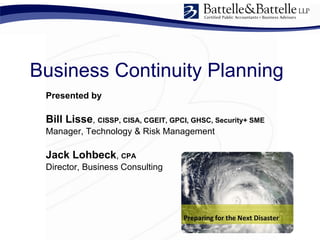
Business Continuity Workshop Final
- 1. Business Continuity Planning Presented by Bill Lisse , CISSP, CISA, CGEIT, GPCI, GHSC, Security+ SME Manager, Technology & Risk Management Jack Lohbeck , CPA Director, Business Consulting
- 8. People Materials Critical Records Office Work Areas Critical Machinery & Equipment Communications Infrastructure BCP Resource Scope
- 9. BCM Cycle Stage 1 Stage 2 Stage 3 Stage 4 Stage 5 Risk Management Business Impact Analysis Business Continuity Strategy Business Continuity Plan Business Continuity Plan Testing BCP Maintenance
- 11. BCM Cycle Stage 1 Stage 2 Stage 3 Stage 4 Stage 5 Risk Management Business Impact Analysis Business Continuity Strategy Business Continuity Plan Business Continuity Plan Testing BCP Maintenance
- 12. Risk Management
- 13. Risks How likely is an adverse outcome? What can go wrong? - Human (Intentional or accidental) - Natural Events What are the consequences of the event? Probability Threats Impacts Foundation History - Analytical Tools - Technology Maturity - Knowledge/Experience
- 15. Vulnerability Threat Opportunity Exposure
- 16. Risk Management Non-critical internal processes Critical internal processes Any external facing processes Which business processes will be affected? No impact Peripheral impact on revenue generation or end-customer support Direct impact on revenue generation or end-customer support How will it impact customers or prospects? Peripheral departmental or project budget Material to a departmental or project budget Material to the company What is the cost to overcome disruptions? Select users throughout the company One or more departments Entire company What is the impact on other projects? No correlation to revenue Peripheral correlation to revenue Direct correlation to revenue What is the impact of the function on revenue generation? Low Impact Medium Impact High Impact Question
- 19. BCM Cycle Stage 1 Stage 2 Stage 3 Stage 4 Stage 5 Risk Management Business Impact Analysis Business Continuity Strategy Business Continuity Plan Business Continuity Plan Testing BCP Maintenance
- 29. BCM Cycle Stage 1 Stage 2 Stage 3 Stage 4 Stage 5 Risk Management Business Impact Analysis Business Continuity Strategy Business Continuity Plan Business Continuity Plan Testing BCP Maintenance
- 32. BCM Cycle Stage 1 Stage 2 Stage 3 Stage 4 Stage 5 Risk Management Business Impact Analysis Business Continuity Strategy Business Continuity Plan Business Continuity Plan Testing BCP Maintenance
- 40. BCM Cycle Stage 1 Stage 2 Stage 3 Stage 4 Stage 5 Risk Management Business Impact Analysis Business Continuity Strategy Business Continuity Plan Business Continuity Plan Testing BCP Maintenance
- 43. BCM Cycle Stage 1 Stage 2 Stage 3 Stage 4 Stage 5 Risk Management Business Impact Analysis Business Continuity Strategy Business Continuity Plan Business Continuity Plan Testing BCP Maintenance
- 47. BCM Cycle - Summary Stage 1 Stage 2 Stage 3 Stage 4 Stage 5 Risk Management Business Impact Analysis Business Continuity Strategy Business Continuity Plan Business Continuity Plan Testing BCP Maintenance
Notas do Editor
- The BIA will be your most time-consuming part of the disaster recovery planning process.Once completed, it provides you with a baseline for Justification for costs associated with recovery.Developing recovery strategies.Developing Support Level AgreementsOnce you’ve identified all your core business process to need to analyze and prioritize them…Let’s look at specifically what you should be thinking about at…
- Prevention - UPS & Generator, system backups and off-site storage, Pre-action sprinkler system, water detection system, Fire system, Cross-trained personnel
- Prevention - UPS & Generator, system backups and off-site storage, Pre-action sprinkler system, water detection system, Fire system, Cross-trained personnel
- Prevention - UPS & Generator, system backups and off-site storage, Pre-action sprinkler system, water detection system, Fire system, Cross-trained personnel
- Prevention - UPS & Generator, system backups and off-site storage, Pre-action sprinkler system, water detection system, Fire system, Cross-trained personnel
- Prevention - UPS & Generator, system backups and off-site storage, Pre-action sprinkler system, water detection system, Fire system, Cross-trained personnel
- Plan AuditBusiness Continuity International will comment on the overall effectiveness of the plans and may suggest adjustment are made to the plans before any further test phases are commenced.Passive Walk ThroughThis Phase will increase the awareness for all
- The Testing ProcessThis is the process to be followed when your organization's Business Continuity Plan (BCP) is tested, in order to assess its viability, and to ensure your staff are fully conversant with the proposals.DependenciesPrior to testing the plan, two previous milestones should have been completed:-Assessing the Risk and Likely Impact Developing the Plan Frequency of TestingHow often, and to what extent, you test your BCP is determined by the nature of the potential changes to systems, personnel, business processes, location, services and infrastructure; plus any legislative or contractual issues. Re-test the BCP whenever material changes have been made to its contents or to the organization's business operations.Testing in Authentic ConditionsWhere the BCP Testing does not reproduce authentic conditions, the value of such testing is limited.Test PlanDevelop a plan to test the BCP. Consider a range of planning activities, including start, stop, objectives, coordination, documentation of results, observers etc.Resource RequirementsResource the Test Plan with the same persons who would be likely to deal with a live situation. Test the plan by making certain key staff ‘unavailable’, simulating where practical the potential absence of personnel in a live situation.Documented Test ProceduresEnsure that the BCP is tested using the documented procedures, thereby testing the adequacy of the instructions.Test ResultsHaving concluded the BCP Test, the results must be analyzed. A failure to undertake this task will likely detract from the value of the test. Learn from the results! The problems arising should be documented and addressed subsequently. You should have a formal mechanism for ensuring that this takes place.Management and Staff AwarenessYou must ensure that knowledge of the BCP is disseminated throughout the organization.
